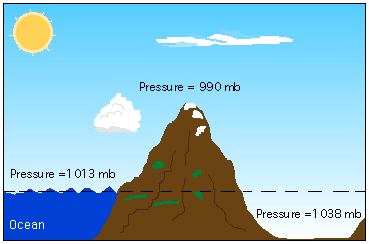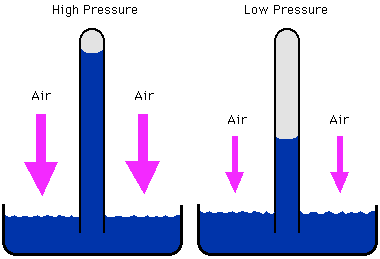 ). Since more molecules are exerting forces in dense air, the pressure is greater. The pressure profile of the atmosphere from Session 1 illustrates the decrease in pressure with height.
). Since more molecules are exerting forces in dense air, the pressure is greater. The pressure profile of the atmosphere from Session 1 illustrates the decrease in pressure with height.
The concept of atmospheric pressure is often a hard one to grasp. It is difficult to think of the atmosphere as having mass because we generally do not notice its weight pressing on our body. As discussed in Session 1, pressure is not only due to the mass of the molecules, but also the motion of the molecules bombarding our body. The atmosphere actually exerts an average force of 14.7 pounds per square inch of area at sea level. Pressure (P) is defined as this force (F) per unit of area (A), i.e, P=F/A. In units that meteorologists are more accustomed to and for computational purposes, the average pressure at sea level is 1013.25 millibars (mb) or 101.325 kiloPascals (kPa) (also equivalent to 29.92 in/Hg and 760 mm/Hg where Hg is the symbol for mercury). Sea level is used as a reference point for height. Areas with elevations below sea level can expect higher average pressures because the air is more dense, while higher elevations can expect lower average pressures. Pressure is proportional to density ( ). Since more molecules are exerting forces in dense air, the pressure is greater. The pressure profile of the atmosphere from Session 1 illustrates the decrease in pressure with height.
). Since more molecules are exerting forces in dense air, the pressure is greater. The pressure profile of the atmosphere from Session 1 illustrates the decrease in pressure with height.

Pressure at the surface is measured with a barometer. While there are many types of barometers, the most commonly used barometers for meteorological purposes are the mercury barometers. A properly calibrated mercury barometer is extremely accurate. These barometers consist of a glass tube filled with liquid mercury and closed on one end. The tube stands on end with the closed end up and the open end submerged in a reservoir of mercury that is exposed to the air. As the air pressure rises, it pushes on the liquid in the reservoir. The level of the mercury rises in the glass tube to compensate for the additional pressure exerted on the exposed reservoir. The average air pressure at sea level as recorded on a mercury barometer is 29.92 inches of mercury (in. Hg) That is, the column of mercury is 29.92 inches high at standard sea level pressure. Though we speak in terms of the average or standard pressure at sea level, the pressure at any place on the surface of the earth is variable and continuously changes with time due to the heating and cooling of the earth. Varying pressures result in a pressure gradient force. This force - the wind - is only one of several that produce motion in the atmosphere, transporting pollutants.

 The Shodor
Education Foundation, Inc.
The Shodor
Education Foundation, Inc.